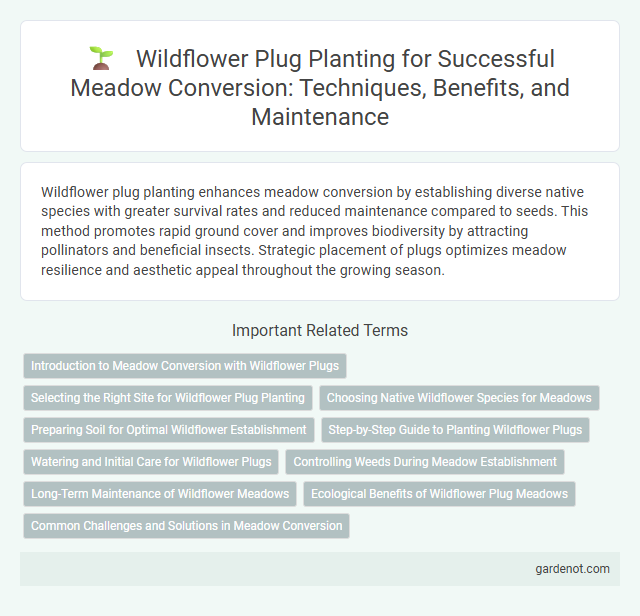Wildflower plug planting enhances meadow conversion by establishing diverse native species with greater survival rates and reduced maintenance compared to seeds. This method promotes rapid ground cover and improves biodiversity by attracting pollinators and beneficial insects. Strategic placement of plugs optimizes meadow resilience and aesthetic appeal throughout the growing season.
Introduction to Meadow Conversion with Wildflower Plugs
Wildflower plug planting accelerates meadow conversion by establishing diverse native species quickly and effectively. These plugs enhance soil health, support pollinators, and increase biodiversity compared to traditional seed sowing methods. Selecting region-specific wildflower plugs ensures optimal growth and ecological compatibility.
Selecting the Right Site for Wildflower Plug Planting
Selecting the right site for wildflower plug planting involves choosing areas with well-drained soil and adequate sunlight exposure, typically full sun to partial shade. Soil pH should range between 6.0 and 7.5 to support diverse wildflower species, and the site must be free from invasive weeds to reduce competition. Proper site selection ensures optimal root establishment and increases the success rate of wildflower plug growth in meadow conversion projects.
Choosing Native Wildflower Species for Meadows
Selecting native wildflower species for meadow conversion enhances ecosystem resilience by supporting local pollinators and wildlife. Native plugs adapt well to soil and climate conditions, ensuring higher survival rates and sustainable growth. Prioritizing species diversity with region-specific wildflowers promotes biodiversity and creates vibrant, self-sustaining meadows.
Preparing Soil for Optimal Wildflower Establishment
Preparing soil for optimal wildflower establishment involves thorough site assessment and soil testing to determine pH and nutrient levels. Incorporating organic matter enhances soil structure and promotes moisture retention, crucial for wildflower plug root development. Removing existing vegetation and loosening compacted soil ensures better plug plant anchorage and reduces competition for resources.
Step-by-Step Guide to Planting Wildflower Plugs
Plant wildflower plugs by first preparing the soil, ensuring it is well-drained and free of weeds to promote healthy root establishment. Space the plugs according to species requirements, gently placing them into pre-dug holes at soil level, and then firm the soil around each plug to eliminate air pockets. Water thoroughly after planting and maintain consistent moisture during the initial growing period to encourage strong root development and successful establishment.
Watering and Initial Care for Wildflower Plugs
Proper watering is crucial for the successful establishment of wildflower plugs, requiring consistent moisture during the first two weeks after planting to prevent drying out. Initial care involves maintaining soil moisture without waterlogging, ideally through gentle irrigation methods such as drip watering or light soaker hoses. Monitoring soil moisture levels daily ensures plugs develop strong root systems, enhancing survival rates and promoting vibrant meadow conversion.
Controlling Weeds During Meadow Establishment
Effective weed control during wildflower plug planting is essential for successful meadow establishment and promotes healthy native plant growth. Using targeted methods like mulching, selective herbicide application, or manual removal helps reduce competition from invasive species. Consistent monitoring in the first growing season ensures early detection and management of weeds, supporting long-term meadow biodiversity.
Long-Term Maintenance of Wildflower Meadows
Wildflower plug planting supports the long-term maintenance of wildflower meadows by establishing robust, native plant populations resistant to weeds and environmental stress. Regular monitoring and targeted management, such as selective mowing and invasive species control, promote plant diversity and meadow resilience over time. Ensuring soil health through periodic assessments and adaptive care further enhances the sustainability of wildflower plug planted meadows.
Ecological Benefits of Wildflower Plug Meadows
Wildflower plug planting enhances biodiversity by providing vital habitats and food sources for pollinators like bees, butterflies, and other beneficial insects. These plug meadows improve soil health through diverse root structures that promote aeration and nutrient cycling, reducing erosion and supporting microfauna. The dense planting of native wildflowers in plugs also aids in carbon sequestration, contributing to climate change mitigation efforts.
Common Challenges and Solutions in Meadow Conversion
Wildflower plug planting in meadow conversion often faces challenges such as poor plug establishment due to soil compaction, inadequate moisture retention, and competition from aggressive weeds. Solutions include using soil decompaction techniques, implementing targeted irrigation strategies to maintain optimal moisture, and applying selective weed control methods to enhance plug survival and growth. Selecting native, site-adapted wildflower species further improves resilience and long-term meadow success.
Wildflower plug planting Infographic

 gardenot.com
gardenot.com